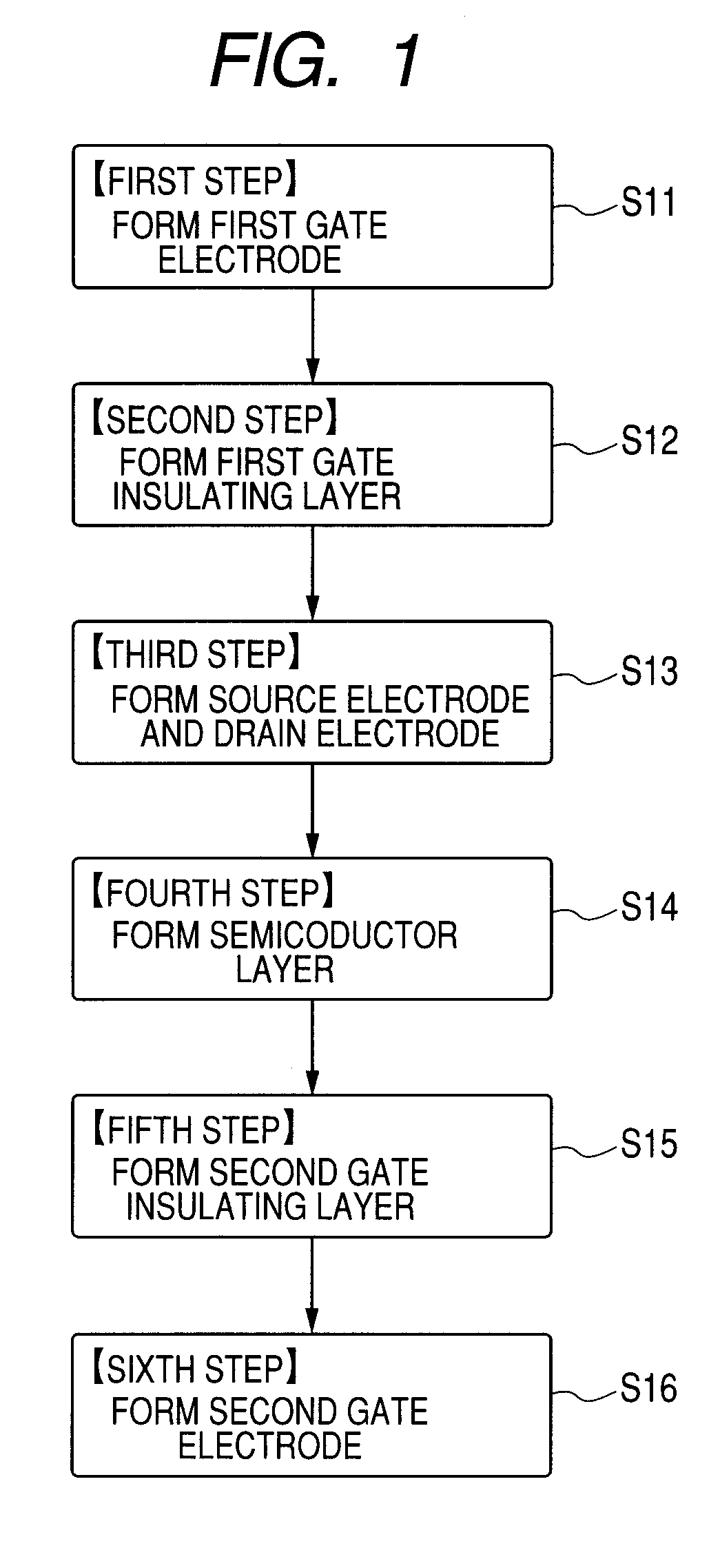Thin film transistor, display device using thin film transistor, and production method of thin film transistor
a technology of thin film transistor and production method, which is applied in the direction of transistors, semiconductor devices, electrical equipment, etc., can solve the problems of deterioration of electrical characteristics, malfunctions such as contrast deterioration, and the inability to obtain the threshold value which is necessary for operating a circuit, etc., and achieve the effect of increasing the number of production steps
- Summary
- Abstract
- Description
- Claims
- Application Information
AI Technical Summary
Benefits of technology
Problems solved by technology
Method used
Image
Examples
first embodiment
[0050](First Embodiment)
[0051]FIG. 3F is a cross-sectional view illustrating a structure of a thin film transistor according to a first embodiment of the present invention. As illustrated in FIG. 3F, this embodiment is an example of a bottom-contact type thin film transistor. The thin film transistor illustrated in FIGS. 3A to 3F is formed on the substrate 1. More specifically, the first gate electrode 2, the first gate insulating layer 3, the source electrode 4, the drain electrode 5, the semiconductor layer 6, the second gate insulating layer 7, and the second gate electrode 8 are formed on the substrate 1.
[0052]A glass substrate (Corning 1737) is used as the substrate 1. A thickness of the glass substrate is 0.5 mm. First, an Mo thin film with a thickness of 100 nm is formed on the substrate 1. In this embodiment, DC magnetron sputtering using an atmosphere of an argon gas is used to form the Mo thin film. Then, the deposited Mo thin film is processed by photolithography and dry ...
second embodiment
[0060](Second Embodiment)
[0061]FIG. 4H is a cross-sectional view illustrating a structure of a display device according to a second embodiment of the present invention. As illustrated in FIG. 4H, the display device according to this embodiment includes the thin film transistor described in the first embodiment and an organic EL element. A thin film transistor 100 illustrated in FIG. 4H is formed on the substrate 1. More specifically, the thin film transistor 100 includes the first gate electrode 2, the first gate insulating layer 3, the source electrode 4, the drain electrode 5, the semiconductor layer 6, the second gate insulating layer 7, and the second gate electrode 8. In addition, an organic EL element 200 illustrated in FIG. 4H is formed on the first gate insulating layer 3. More specifically, the organic EL element 200 includes a transparent anode electrode 9, a hole injecting layer 10, an organic light emitting layer 11, an electron injecting layer 12, and a cathode electrod...
third embodiment
[0073](Third Embodiment)
[0074]FIG. 8F is a cross-sectional view illustrating a structure of a thin film transistor according to a third embodiment of the present invention. In FIG. 8F, a cross-section perpendicular to a channel length direction of the thin film transistor (left) and a cross-section perpendicular to a channel width direction of the thin film transistor (right) are illustrated. As illustrated in FIG. 8F, this embodiment uses a channel-etch type thin film transistor as an example. Note that, in this embodiment, a case where the side-wall light-shielding layer is formed on both the sides of the semiconductor layer is described. However, by similar steps, the side-wall light-shielding layer may be formed only on one side of the semiconductor layer. The thin film transistor illustrated in FIGS. 8A to 8F is formed on the substrate 1. More specifically, the first gate electrode 2, the first gate insulating layer 3, the semiconductor layer 6, the source electrode 4, the drai...
PUM
 Login to View More
Login to View More Abstract
Description
Claims
Application Information
 Login to View More
Login to View More - R&D
- Intellectual Property
- Life Sciences
- Materials
- Tech Scout
- Unparalleled Data Quality
- Higher Quality Content
- 60% Fewer Hallucinations
Browse by: Latest US Patents, China's latest patents, Technical Efficacy Thesaurus, Application Domain, Technology Topic, Popular Technical Reports.
© 2025 PatSnap. All rights reserved.Legal|Privacy policy|Modern Slavery Act Transparency Statement|Sitemap|About US| Contact US: help@patsnap.com



